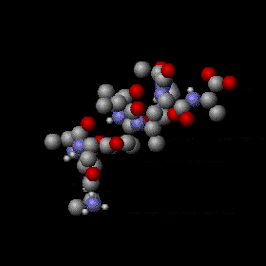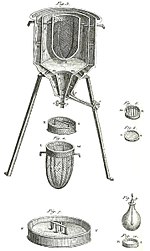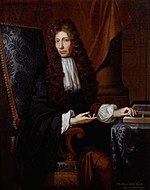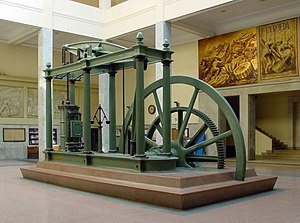Thermodynamics is a branch of physics that studies the movement of energy and how energy instills movement. More precisely, it studies the effects of changes in temperature, pressure, and volume on physical systems at the macroscopic scale by analyzing the collective motion of their particles using statistics. 19th century physicists defined three Laws of thermodynamics to sum up the basic principles of the subject; in the 20th century, an unofficial "zeroth law" was added.
The history of thermodynamics is a fundamental strand in the history of physics, the history of chemistry, and the history of science in general. Owing to the relevance of thermodynamics in much of science and technology, its history is finely woven with the developments of classical mechanics, quantum mechanics, magnetism, and chemical kinetics, to more distant applied fields such as meteorology, information theory, and biology (physiology), and to technological developments such as the steam engine, internal combustion engine, cryogenics and electricity generation. The development of thermodynamics both drove and was driven by atomic theory. It also, albeit in a subtle manner, motivated new directions in probability and statistics; see, for example, the timeline of thermodynamics.
Contributions from ancient and medieval times
See also: History of heat and Vacuum
The ancients viewed heat as that related to fire. In 3000 BC, the ancient Egyptians viewed heat as related to origin mythologies.[1] In the Western philosophical tradition, after much debate about the primal element among earlier pre-Socratic philosophers, Empedocles proposed a four-element theory, in which all substances derive from earth, water, air, and fire. The Empedoclean element of fire is perhaps the principal ancestor of later concepts such as phlogiston and caloric. Around 500 BC, the Greek philosopher Heraclitus
became famous as the "flux and fire" philosopher for his proverbial
utterance: "All things are flowing." Heraclitus argued that the three principal elements in nature were fire, earth, and water.
Heating a body, such as a segment of protein alpha helix (above), tends to cause its atoms to vibrate more, and to expand or change phase, if heating is continued; an axiom of nature noted by Herman Boerhaave in the in 1700s.
The 5th century BC, Greek philosopher Parmenides, in his only known work, a poem conventionally titled On Nature, uses verbal reasoning to postulate that a void, essentially what is now known as a vacuum, in nature could not occur. This view was supported by the arguments of Aristotle, but was criticized by Leucippus and Hero of Alexandria. From antiquity to the Middle Ages various arguments were put forward to prove or disapprove the existence of a vacuum and several attempts were made to construct a vacuum but all proved unsuccessful.
The European scientists Cornelius Drebbel, Robert Fludd, Galileo Galilei and Santorio Santorio in the 16th and 17th centuries were able to gauge the relative "coldness" or "hotness" of air, using a rudimentary air thermometer (or thermoscope). This may have been influenced by an earlier device which could expand and contract the air constructed by Philo of Byzantium and Hero of Alexandria.
Around 1600, the English philosopher and scientist Francis Bacon surmised: "Heat itself, its essence and quiddity is motion and nothing else." In 1643, Galileo Galilei, while generally accepting the 'sucking' explanation of horror vacui proposed by Aristotle, believed that nature’s vacuum-abhorrence is limited. Pumps operating in mines had already proven that nature would only fill a vacuum with water up to a height of ~30 feet. Knowing this curious fact, Galileo encouraged his former pupil Evangelista Torricelli to investigate these supposed limitations. Torricelli did not believe that vacuum-abhorrence (Horror vacui) in the sense of Aristotle's 'sucking' perspective, was responsible for raising the water. Rather, he reasoned, it was the result of the pressure exerted on the liquid by the surrounding air.
To prove this theory, he filled a long glass tube (sealed at one end) with mercury and upended it into a dish also containing mercury. Only a portion of the tube emptied (as shown adjacent); ~30 inches of the liquid remained. As the mercury emptied, and a vacuum was created at the top of the tube. This, the first man-made vacuum, effectively disproved Aristotle’s 'sucking' theory and affirmed the existence of vacuums in nature. The gravitational force on the heavy element that is Mercury prevented it from filling the vacuum. Nature may abhor a vacuum, but gravity does not care.
Transition from chemistry to Thermochemistry

The first substantial experimental challenges to caloric theory arose in Rumford's 1798 work, when he showed that boring cast iron cannons produced great amounts of heat which he ascribed to friction, and his work was among the first to undermine the caloric theory. The development of the steam engine also focused attention on calorimetry and the amount of heat produced from different types of coal. The first quantitative research on the heat changes during chemical reactions was initiated by Lavoisier using an ice calorimeter following research by Joseph Black on the latent heat of water.
More quantitative studies by James Prescott Joule in 1843 onwards provided soundly reproducible phenomena, and helped to place the subject of thermodynamics on a solid footing. William Thomson, for example, was still trying to explain Joule's observations within a caloric framework as late as 1850. The utility and explanatory power of kinetic theory, however, soon started to displace caloric and it was largely obsolete by the end of the 19th century. Joseph Black and Lavoisier made important contributions in the precise measurement of heat changes using the calorimeter, a subject which became known as thermochemistry.
Phenomenological thermodynamics
- Boyle's law (1662)
- Charles's law was first published by Joseph Louis Gay-Lussac in 1802, but he referenced unpublished work by Jacques Charles from around 1787. The relationship had been anticipated by the work of Guillaume Amontons in 1702.
- Gay-Lussac's law (1802)

Birth of thermodynamics as science
At its origins, thermodynamics was the study of engines. A precursor of the engine was designed by the German scientist Otto von Guericke who, in 1650, designed and built the world's first vacuum pump and created the world's first ever vacuum known as the Magdeburg hemispheres. He was driven to make a vacuum in order to disprove Aristotle's long-held supposition that 'Nature abhors a vacuum'.Shortly thereafter, Irish physicist and chemist Robert Boyle had learned of Guericke's designs and in 1656, in coordination with English scientist Robert Hooke, built an air pump. Using this pump, Boyle and Hooke noticed the pressure-volume correlation: P.V=constant. In that time, air was assumed to be a system of motionless particles, and not interpreted as a system of moving molecules. The concept of thermal motion came two centuries later. Therefore Boyle's publication in 1660 speaks about a mechanical concept: the air spring.[2] Later, after the invention of the thermometer, the property temperature could be quantified. This tool gave Gay-Lussac the opportunity to derive his law, which led shortly later to the ideal gas law. But, already before the establishment of the ideal gas law, an associate of Boyle's named Denis Papin built in 1679 a bone digester, which is a closed vessel with a tightly fitting lid that confines steam until a high pressure is generated.
Later designs implemented a steam release valve to keep the machine from exploding. By watching the valve rhythmically move up and down, Papin conceived of the idea of a piston and cylinder engine. He did not however follow through with his design. Nevertheless, in 1697, based on Papin’s designs, engineer Thomas Savery built the first engine. Although these early engines were crude and inefficient, they attracted the attention of the leading scientists of the time. One such scientist was Sadi Carnot, the “father of thermodynamics”, who in 1824 published “Reflections on the Motive Power of Fire”, a discourse on heat, power, and engine efficiency. This marks the start of thermodynamics as a modern science.


In 1843, James Joule experimentally found the mechanical equivalent of heat. In 1845, Joule reported his best-known experiment, involving the use of a falling weight to spin a paddle-wheel in a barrel of water, which allowed him to estimate a mechanical equivalent of heat of 819 ft·lbf/Btu (4.41 J/cal). This led to the theory of conservation of energy and explained why heat can do a work.[3]
The name "thermodynamics," however, did not arrive until 1849, when the British mathematician and physicist William Thomson (Lord Kelvin) coined the term thermodynamics in a paper on the efficiency of steam engines.
In 1850, the famed mathematical physicist Rudolf Clausius defined the term entropy S to be the heat lost or turned into waste, stemming from the Greek word entrepein meaning to turn.
In association with Clausius, in 1871, a Scottish mathematician and physicist James Clerk Maxwell formulated a new branch of thermodynamics called Statistical Thermodynamics, which functions to analyze large numbers of particles at equilibrium, i.e., systems where no changes are occurring, such that only their average properties as temperature T, pressure P, and volume V become important.
Soon thereafter, in 1875, the Austrian physicist Ludwig Boltzmann formulated a precise connection between entropy S and molecular motion:
The following year, 1876, was a seminal point in the development of human thought. During this essential period, chemical engineer Willard Gibbs, the first person in America to be awarded a PhD in engineering (Yale), published an obscure 300-page paper titled: On the Equilibrium of Heterogeneous Substances, wherein he formulated one grand equality, the Gibbs free energy equation, which gives a measure the amount of "useful work" attainable in reacting systems. Gibbs also originated the concept we now know as enthalpy H, calling it "a heat function for constant pressure".[4] The modern word enthalpy would be coined many years later by Heike Kamerlingh Onnes,[5] who based it on the Greek word enthalpein meaning to warm.
Building on these foundations, those as Lars Onsager, Erwin Schrödinger, and Ilya Prigogine, and others, functioned to bring these engine "concepts" into the thoroughfare of almost every modern-day branch of science.
Kinetic theory
Main article: Kinetic theory
The idea that heat is a form of motion is perhaps an ancient one and is certainly discussed by Francis Bacon in 1620 in his Novum Organum. The first written scientific reflection on the microscopic nature of heat is probably to be found in a work by Mikhail Lomonosov, in which he wrote:- "(..) movement should not be denied based on the fact it is not seen. Who would deny that the leaves of trees move when rustled by a wind, despite it being unobservable from large distances? Just as in this case motion remains hidden due to perspective, it remains hidden in warm bodies due to the extremely small sizes of the moving particles. In both cases, the viewing angle is so small that neither the object nor their movement can be seen."
John Herapath later independently formulated a kinetic theory in 1820, but mistakenly associated temperature with momentum rather than vis viva or kinetic energy. His work ultimately failed peer review and was neglected. John James Waterston in 1843 provided a largely accurate account, again independently, but his work received the same reception, failing peer review even from someone as well-disposed to the kinetic principle as Davy.
Further progress in kinetic theory started only in the middle of the 19th century, with the works of Rudolf Clausius, James Clerk Maxwell, and Ludwig Boltzmann. In his 1857 work On the nature of the motion called heat, Clausius for the first time clearly states that heat is the average kinetic energy of molecules. This interested Maxwell, who in 1859 derived the momentum distribution later named after him. Boltzmann subsequently generalized his distribution for the case of gases in external fields.
Boltzmann is perhaps the most significant contributor to kinetic theory, as he introduced many of the fundamental concepts in the theory. Besides the Maxwell-Boltzmann distribution mentioned above, he also associated the kinetic energy of particles with their degrees of freedom. The Boltzmann equation for the distribution function of a gas in non-equilibrium states is still the most effective equation for studying transport phenomena in gases and metals. By introducing the concept of thermodynamic probability as the number of microstates corresponding to the current macrostate, he showed that its logarithm is proportional to entropy.
and many more!

